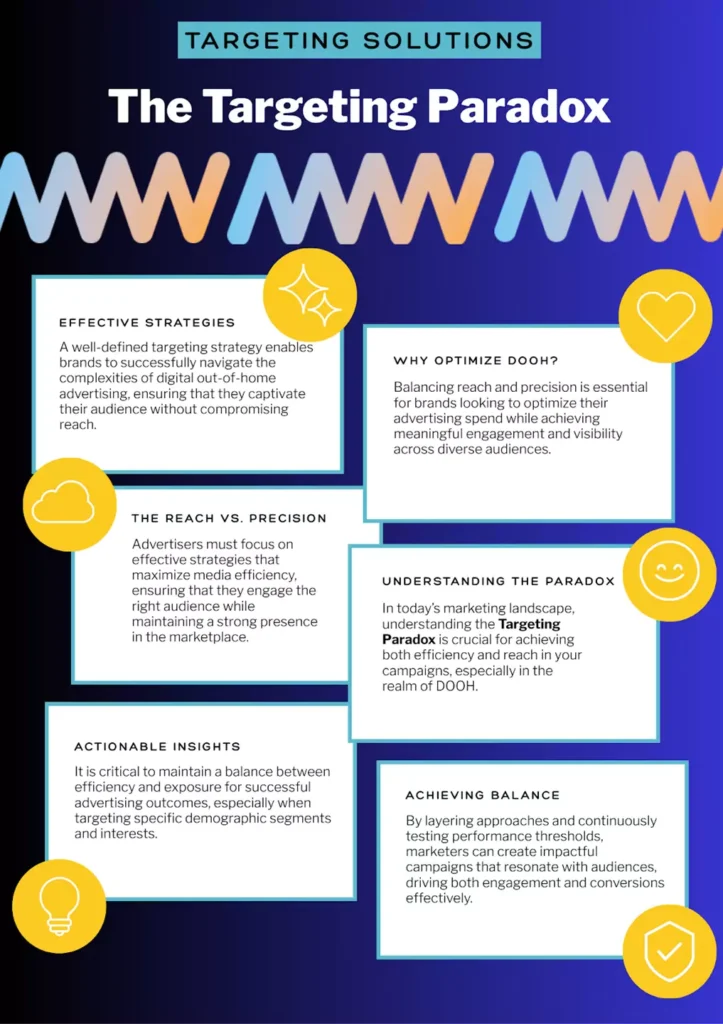August 18, 2025
The Targeting Paradox: How to Optimize DOOH Without Killing Your Reach
By Srikanth Ramachandran, Founder & CEO of Moving Walls Group
Why Targeting Matters in DOOH
In marketing, precision has always been the holy grail. We imagine campaigns where every impression reaches the right person, at the right time, with the perfect message. But reality is far messier. Most campaigns are a constant balancing act between reach, relevance, and budget and in Digital Out-of-Home (DOOH), that act becomes even harder to master.
We’re speaking to two audiences here. Large brands that often believe they can simply “buy loops”owning screens for a block of time and rely on sheer volume to deliver results. It feels safe, but it leaves efficiency and precision on the table. And small brands that see DOOH as a luxury channel, assuming it’s out of reach compared to digital-first options. Many don’t realize that optimization can make DOOH accessible, even on modest budgets.
The Reality Check: One-to-Many, Not One-to-One
The truth is that DOOH isn’t one-to-one like digital; it’s one-to-many. A single screen in a busy square can display your ad to tens of thousands of people a day, but only a fraction will be your exact target audience. If you’re chasing ultra-specific segments like IT decision makers or luxury SUV buyers, some wastage is inevitable. The question becomes: if perfect precision isn’t possible, why optimize at all?
Why Optimization Still Matters
Optimization in DOOH isn’t about excluding everyone outside your perfect profile, it’s about improving your odds while keeping your stage big enough to matter. Done right, targeting helps large brands maintain scale while gaining precision, avoiding wasteful blanket buys. It makes DOOH affordable for smaller brands, by letting them buy smarter instead of bigger. It increases media efficiency by focusing on the right screens and contexts. And most importantly, it boosts campaign results without requiring a blockbuster budget.
The goal isn’t to speak to one person in the crowd, it’s to own the right crowd.
The Reach–Precision Curve
This is where the concept of the reach precision curve comes in. In digital advertising, the more precise your targeting, the less reach you usually have. In DOOH, the drop-off is even sharper because inventory is tied to physical locations and real-world audience flows. Push too far toward hyper-targeting, and your ads end up serving almost no one.
The trick is finding the sweet spot that’s precise enough to make an impact, broad enough to scale. Think of it like fishing: a net that’s too fine barely catches anything, a net too wide collects fish and plenty of junk, but a net just right gets you the right fish in good numbers.
The Broad-to-Niche Ladder of Segmentation
To make this practical, brands can think about a broad-to-niche ladder of segmentation.
- Tier 1: Demographics (age, gender) broadest, reaching up to 60% of adults.
- Tier 2: Geography cities, neighborhoods, or a 5km radius for strong relevance.
- Tier 3: Daypart & Context commuter hours, lunch breaks, nightlife.
- Tier 4: Lifestyle & Interests coffee lovers, sports enthusiasts.
- Tier 5: Behavior & Intent frequent flyers, gym-goers.
- Tier 6: Professional Affinities IT decision makers, healthcare professionals.
- Tier 7: Event & Moment Triggers marathon participants, concertgoers.
The biggest mistake brands make is leaping from Tier 1 to Tier 7, bypassing the steps in between. Each layer of targeting should be tested with a reach check. If your available impressions fall below 5% of total, you’ve likely gone too far.
Targeting Solutions

Smarter Targeting in Action
Instead of slicing too deep, layering strategies help maintain relevance without destroying scale. Event-based and time-based triggers can also add contextual punch without wiping out your audience. And programmatic buying makes this easier by dynamically shifting spend to where reach and relevance align best.
Imagine launching a premium coffee subscription. You start with adults aged 25–45 in key metro areas. Then, you add geography filters to focus on affluent neighborhoods. From there, you use daypart targeting to catch commuters during the morning rush. Next, you introduce lifestyle targeting for known coffee lovers. At each step, you’re checking reach. If the pool gets too small, you loosen a filter.
For a global coffee chain, this strategy makes large-scale campaigns more efficient. For a local roastery, it makes DOOH as targeted as digital, but without the prohibitive price tag.
Resolving the Paradox
And this is where the paradox resolves itself. DOOH isn’t about whispering your message to one perfect stranger. It’s about stepping onto the busiest stage in the city and making sure the right majority hears you. Over-target, and you risk becoming invisible. Under-target, and you become background noise.
The winners will be the brands that master this balance and the ones that optimize just enough to matter, but never so much that they vanish.
For large brands, that means no more wasting entire loops on the wrong crowd. For small brands, it means realizing that DOOH isn’t out of reach after all, it just needs to be bought with intelligence. The targeting paradox is not a problem to solve, but a skill to master.

About the Author
Srikanth Ramachandran is a distinguished architect of the modern media-tech landscape and the Founder and Group CEO of Moving Walls, a globally awarded enterprise shaping how brands engage audiences in motion. With an unerring eye for the future, he has led the company to global acclaim from TiE50 to Unilever Foundry30 and Campaign Asia’s Most Valuable Product by marrying data precision with contextual storytelling across the physical world. Educated at Nanyang Business School and seasoned by leadership tenures at IBM Singapore, Srikanth also founded Knowledge Dynamics, which later merged with a NYSE publicly listed firm. His career is defined by an elegant fusion of strategic insight and technological stewardship.
A firm believer in technology’s moral imperative, Srikanth champions the idea that innovations especially in AI must not only scale but serve, enriching human experience while upholding social integrity. His voice remains one of the region’s most influential in bridging the divide between what is possible and what is purposeful.
Scale up your OOH Ads with better ROAS today.